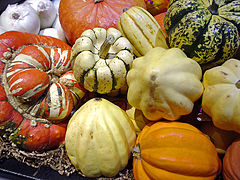Winter squash

Winter squash is an annual fruit representing several squash species within the genus Cucurbita. It differs from summer squash in that it is harvested and eaten in the mature stage when the seeds within have matured fully and the skin has hardened into a tough rind. At this stage, most varieties of this vegetable can be stored for use during the winter. Winter squash is generally cooked before being eaten, and the skin or rind is not usually eaten as it is with summer squash.[1]
Cultivars of winter squash that are round and orange are called pumpkins. In New Zealand and Australian English, the term "pumpkin" generally refers to the broader category called "winter squash".[2]
Planting and harvesting[]
Squash is a frost-tender plant meaning that the seeds do not germinate in cold soil. Winter squash seeds germinate best when the soil temperature is 21 to 35 °C (70 to 95 °F), with the warmer end of the range being optimal.[3] It is harvested whenever the fruit has turned a deep, solid color and the skin is hard. Most winter squash is harvested in September or October in the Northern Hemisphere, before the danger of heavy frosts.[citation needed]
Nutritional value[]
| Nutritional value per 100 g (3.5 oz) | |
|---|---|
8.59g | |
| Sugars | 2.2 g |
| Dietary fiber | 1.5g |
0.13 g | |
0.95 g | |
| Vitamins | Quantity %DV† |
| Vitamin A equiv. | 9% 68 μg8% 820 μg38 μg |
| Thiamine (B1) | 3% 0.04 mg |
| Riboflavin (B2) | 5% 0.062 mg |
| Niacin (B3) | 3% 0.5 mg |
| Pantothenic acid (B5) | 4% 0.188 mg |
| Vitamin B6 | 12% 0.156 mg |
| Folate (B9) | 6% 24 μg |
| Vitamin C | 15% 12.3 mg |
| Minerals | Quantity %DV† |
| Calcium | 3% 28 mg |
| Iron | 4% 0.58 mg |
| Magnesium | 4% 15 mg |
| Manganese | 8% 0.164 mg |
| Phosphorus | 3% 24 mg |
| Potassium | 7% 350 mg |
| |
| †Percentages are roughly approximated using US recommendations for adults. Source: USDA FoodData Central | |
Winter squash is a low-calorie food and a good source of complex vegetable carbohydrates and dietary fiber. It is an excellent source of vitamin A, a great source of vitamin C, potassium, dietary fiber and manganese, and a good source of folate, omega-3 fatty acids, vitamin B1 (thiamin), copper, tryptophan, vitamin B6 (pyridoxine), vitamin B3 (niacin) and vitamin B5 (pantothenic acid).[4] It is also a source of iron and beta-carotene. Usually, the darker the skin is, the higher the beta-carotene content.[5]
Subspecies, cultivars and varieties[]
This section needs additional citations for verification. (January 2021) |
Cucurbita maxima[]
- Ambercup squash
- Arikara squash
- Atlantic Giant
- Banana squash
- Buttercup squash
- Hubbard squash
- Jarrahdale pumpkin
- Kabocha - "Hokkaido squash"
- Lakota squash
- Red kuri squash - also called "orange Hokkaido squash" or "baby red Hubbard squash"
- Turban squash
Cucurbita argyrosperma[]
- Cushaw squash (also called "winter crookneck squash")
Cucurbita moschata[]


- Butternut squash
- Calabaza
- or Musquee de Provence[6]
Cucurbita pepo[]
- Acorn squash
- Delicata squash
- Field pumpkin
- Spaghetti squash
See also[]
References[]
- ^ "Winter Squash". University of Illinois Extension. Retrieved September 15, 2013.
- ^ Ferriol, María; Picó, Belén (2007). "3". Handbook of Plant Breeding: Vegetables I. New York: Springer. p. 317. ISBN 978-0-387-72291-7.
The common terms "pumpkin", "squash", "gourd", "cushaw", "ayote", "zapallo", "calabaza", etc. are often applied indiscriminately to different cultivated species of the New World genus Cucurbita L. (Cucurbitaceae): C. pepo L., C. maxima Duchesne, C. moschata Duchesne, C. argyrosperma C. Huber and C. ficifolia Bouché.
- ^ Nonnecke, Ib Libner (1989). Vegetable Production. New York: Van Nostrand Reinhold. p. 534. ISBN 0-442-26721-5.
- ^ "Squash, winter". whfoods.org. The George Mateljan Foundation. Retrieved 2013-08-28.
- ^ "Vitamin A". National Library of Medicine, National Institutes of Health. Retrieved September 15, 2013.
- ^ "Squash". What's Cooking America. Retrieved 2013-08-28.
External links[]
- Squashes and pumpkins
- Thanksgiving food
